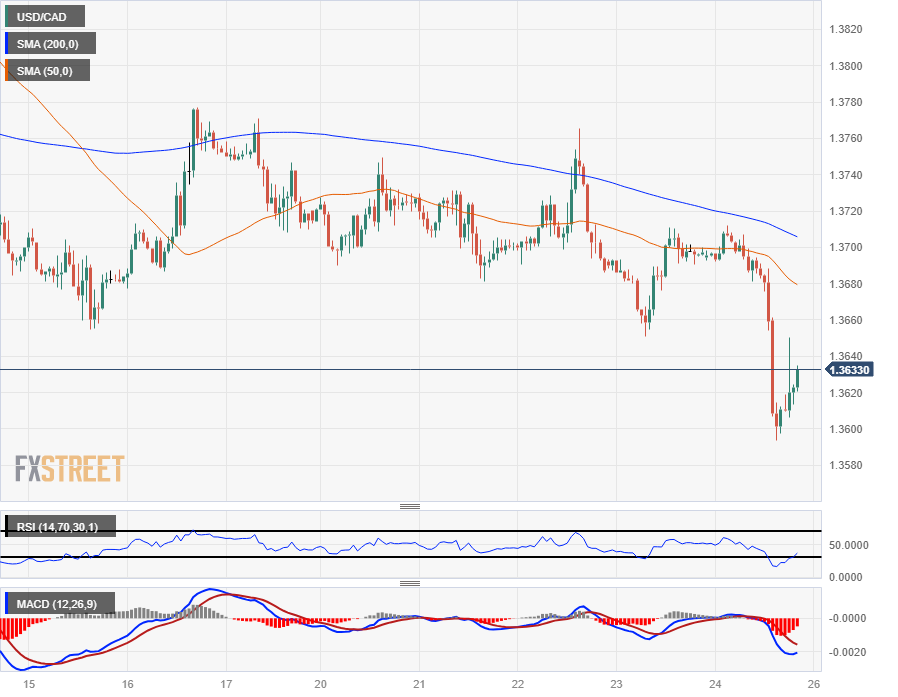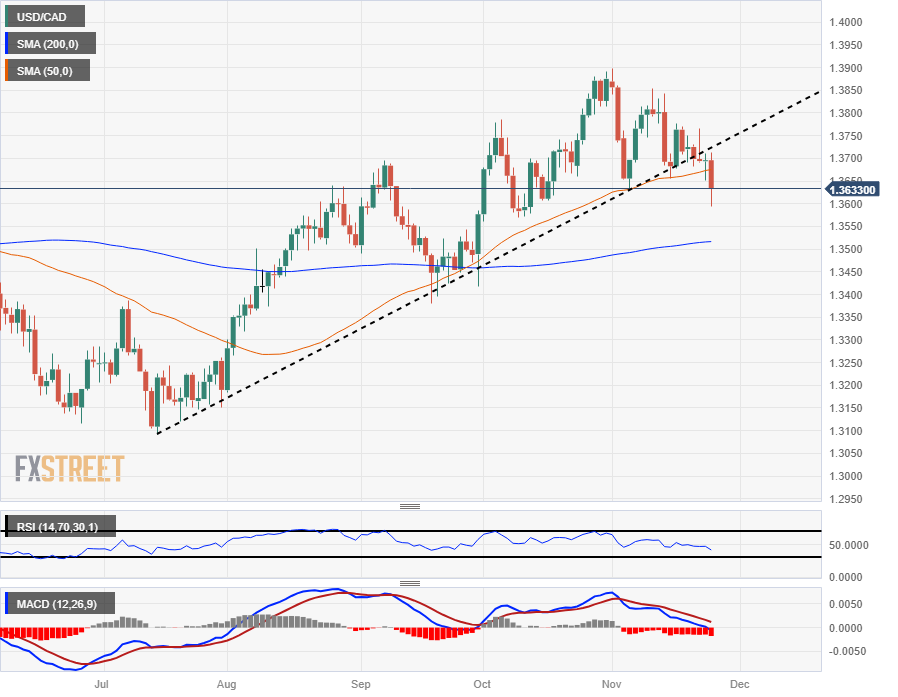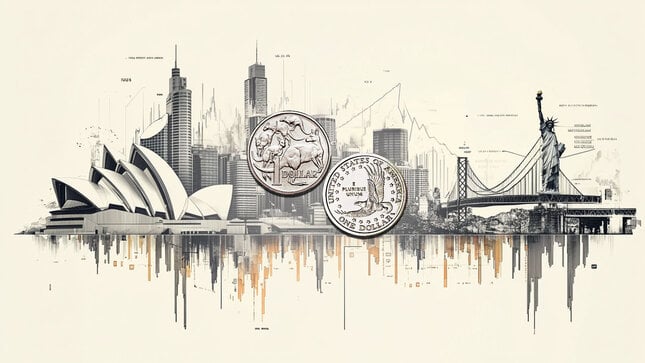- The Canadian Dollar found its highest bids in nearly six weeks on data beats.
- Retail Sales in Canada gave a surprise 0.6% jump in September.
- The Loonie was firmer on Friday as market sentiment spun up to close out the week.
The Canadian Dollar (CAD) found some bullish momentum in the latter half of Friday’s trading session, taking the USD/CAD pair down into the 1.3600 region.
A better-than-expected Retail Sales report and a broad market recovery in risk sentiment are bolstering the Loonie against the US Dollar (USD), with the CAD up across the board and the Greenback on the softer side heading into the trading week’s close.
Canadian Dollar price this week
The table below shows the percentage change of Canadian Dollar (CAD) against listed major currencies this week. Canadian Dollar was the strongest against the US Dollar.
| USD | EUR | GBP | CAD | AUD | JPY | NZD | CHF | |
| USD | -0.35% | -1.25% | -0.63% | -1.15% | -0.32% | -1.52% | -0.45% | |
| EUR | 0.35% | -0.91% | -0.28% | -0.79% | 0.04% | -1.16% | -0.10% | |
| GBP | 1.24% | 0.90% | 0.62% | 0.12% | 0.94% | -0.25% | 0.80% | |
| CAD | 0.64% | 0.27% | -0.63% | -0.52% | 0.31% | -0.89% | 0.18% | |
| AUD | 1.13% | 0.79% | -0.11% | 0.51% | 0.82% | -0.37% | 0.69% | |
| JPY | 0.32% | -0.04% | -1.17% | -0.31% | -0.81% | -1.20% | -0.13% | |
| NZD | 1.52% | 1.15% | 0.26% | 0.89% | 0.36% | 1.19% | 1.04% | |
| CHF | 0.46% | 0.11% | -0.81% | -0.17% | -0.70% | 0.16% | -1.07% |
The heat map shows percentage changes of major currencies against each other. The base currency is picked from the left column, while the quote currency is picked from the top row. For example, if you pick the Euro from the left column and move along the horizontal line to the Japanese Yen, the percentage change displayed in the box will represent EUR (base)/JPY (quote).
Daily Digest Market Movers: Canadian Dollar finds a rebound, USD/CAD back into 1.3600
- The CAD is back in action, climbing against all of the majors on Friday.
- Retail Sales within Canada surged 0.6% in September, well above Wall Street’s no-change forecast and walking back August’s -0.1% print.
- Core Retail Sales (excluding automobiles, gas station purchases and car parts) still rose 0.2%.
- Retail Sales were still up 0.3% in September by volume.
- 3Q Retail Sales up 0.6%, Retail Sales volume down 0.5% over the same period.
- US Purchasing Managers Index (PMI) in November saw a weakening Manufacturing component, injuring the Greenback.
- US Composite PMI in November held steady at 50.7 as the Manufacturing and Services components were mixed.
- US Manufacturing PMI down from 50.0 to 49.4, missing the forecast of 49.8.
- US Services PMI edged higher from 50.6 to 50.8, beating the expected slip to 50.4.
Technical Analysis: Canadian Dollar rebounds in the trading week’s eleventh hour, drags USD/CAD back down to 1.3600
The Loonie’s late break sees the USD/CAD challenging the 1.3600 handle, with the pair aimed straight at the 1.3500 target, just past the 200-day Simple Moving Average (SMA). A late break for the US Dollar saw the USD/CAD briefly retest 1.3650, but overall market sentiment is maintaining control heading into the close. The pair is continuing to test into the downside, around 1.3620.
The pair has decisively broken through the rising trendline from July’s low bids at 1.3100, and technical support from the 50-day SMA has broken through.
Intraday declines in the USD/CAD has hourly candles pulling well away from the near-term mid-ranges, dropping into 1.3600. Any bullish rebounds will be seeing a technical resistance range between the 50- and 200-day SMAs, which are dropping into 1.3680 and 1.3700, respectively.
USD/CAD Hourly Chart

USD/CAD Daily Chart

Canadian Dollar FAQs
What key factors drive the Canadian Dollar?
The key factors driving the Canadian Dollar (CAD) are the level of interest rates set by the Bank of Canada (BoC), the price of Oil, Canada’s largest export, the health of its economy, inflation and the Trade Balance, which is the difference between the value of Canada’s exports versus its imports. Other factors include market sentiment – whether investors are taking on more risky assets (risk-on) or seeking safe-havens (risk-off) – with risk-on being CAD-positive. As its largest trading partner, the health of the US economy is also a key factor influencing the Canadian Dollar.
How do the decisions of the Bank of Canada impact the Canadian Dollar?
The Bank of Canada (BoC) has a significant influence on the Canadian Dollar by setting the level of interest rates that banks can lend to one another. This influences the level of interest rates for everyone. The main goal of the BoC is to maintain inflation at 1-3% by adjusting interest rates up or down. Relatively higher interest rates tend to be positive for the CAD. The Bank of Canada can also use quantitative easing and tightening to influence credit conditions, with the former CAD-negative and the latter CAD-positive.
How does the price of Oil impact the Canadian Dollar?
The price of Oil is a key factor impacting the value of the Canadian Dollar. Petroleum is Canada’s biggest export, so Oil price tends to have an immediate impact on the CAD value. Generally, if Oil price rises CAD also goes up, as aggregate demand for the currency increases. The opposite is the case if the price of Oil falls. Higher Oil prices also tend to result in a greater likelihood of a positive Trade Balance, which is also supportive of the CAD.
How does inflation data impact the value of the Canadian Dollar?
While inflation had always traditionally been thought of as a negative factor for a currency since it lowers the value of money, the opposite has actually been the case in modern times with the relaxation of cross-border capital controls. Higher inflation tends to lead central banks to put up interest rates which attracts more capital inflows from global investors seeking a lucrative place to keep their money. This increases demand for the local currency, which in Canada’s case is the Canadian Dollar.
How does economic data influence the value of the Canadian Dollar?
Macroeconomic data releases gauge the health of the economy and can have an impact on the Canadian Dollar. Indicators such as GDP, Manufacturing and Services PMIs, employment, and consumer sentiment surveys can all influence the direction of the CAD. A strong economy is good for the Canadian Dollar. Not only does it attract more foreign investment but it may encourage the Bank of Canada to put up interest rates, leading to a stronger currency. If economic data is weak, however, the CAD is likely to fall.
Information on these pages contains forward-looking statements that involve risks and uncertainties. Markets and instruments profiled on this page are for informational purposes only and should not in any way come across as a recommendation to buy or sell in these assets. You should do your own thorough research before making any investment decisions. FXStreet does not in any way guarantee that this information is free from mistakes, errors, or material misstatements. It also does not guarantee that this information is of a timely nature. Investing in Open Markets involves a great deal of risk, including the loss of all or a portion of your investment, as well as emotional distress. All risks, losses and costs associated with investing, including total loss of principal, are your responsibility. The views and opinions expressed in this article are those of the authors and do not necessarily reflect the official policy or position of FXStreet nor its advertisers. The author will not be held responsible for information that is found at the end of links posted on this page.
If not otherwise explicitly mentioned in the body of the article, at the time of writing, the author has no position in any stock mentioned in this article and no business relationship with any company mentioned. The author has not received compensation for writing this article, other than from FXStreet.
FXStreet and the author do not provide personalized recommendations. The author makes no representations as to the accuracy, completeness, or suitability of this information. FXStreet and the author will not be liable for any errors, omissions or any losses, injuries or damages arising from this information and its display or use. Errors and omissions excepted.
The author and FXStreet are not registered investment advisors and nothing in this article is intended to be investment advice.
Recommended content
Editors’ Picks

AUD/USD stays firm near 0.6300 after strong Chinese exports data
AUD/USD is trading well bid near 0.6300 in Asian trades on Monday, opening the week on the front foot. Risk sentiment remains in a sweeter spot following the weekend's news of lower US tariffs on Chinese electronic supply chain and strong Chinese exports data for March. Tariffs talks will remain on the radar.

USD/JPY recovers to 143.00 amid volatile trading
USD/JPY is trimming losses to retake 143\.00 in Monday's Asian trading. The US Dollar pauses its latest leg down, with traders digesting Trump's tariff news from the weekend. However, the Fed-BoJ policy divergence expectations underpin the Japanese Yen, keeping the weight intact on the pair.

Gold retreats from record highs of $3,245 as US Dollar finds its feet
Gold is rereating from record highs of $3,245 early Monday, extending Friday's late pullback. Reducded demand for safe-havens and a broad US Dollar rebound undermine the yellow metal amid the news of not-so-steep US tariffs on China's semiconductors and electronics.

Week ahead: ECB set to cut, BoC might pause as Trump U-turns on tariffs
ECB is expected to trim rates, but the BoC might pause this time. CPI data also in the spotlight; due in UK, Canada, New Zealand and Japan. Retail sales the main release in the United States. China GDP eyed as Beijing not spared by Trump.

Is a recession looming?
Wall Street skyrockets after Trump announces tariff delay. But gains remain limited as Trade War with China continues. Recession odds have eased, but investors remain fearful. The worst may not be over, deeper market wounds still possible.

The Best brokers to trade EUR/USD
SPONSORED Discover the top brokers for trading EUR/USD in 2025. Our list features brokers with competitive spreads, fast execution, and powerful platforms. Whether you're a beginner or an expert, find the right partner to navigate the dynamic Forex market.



